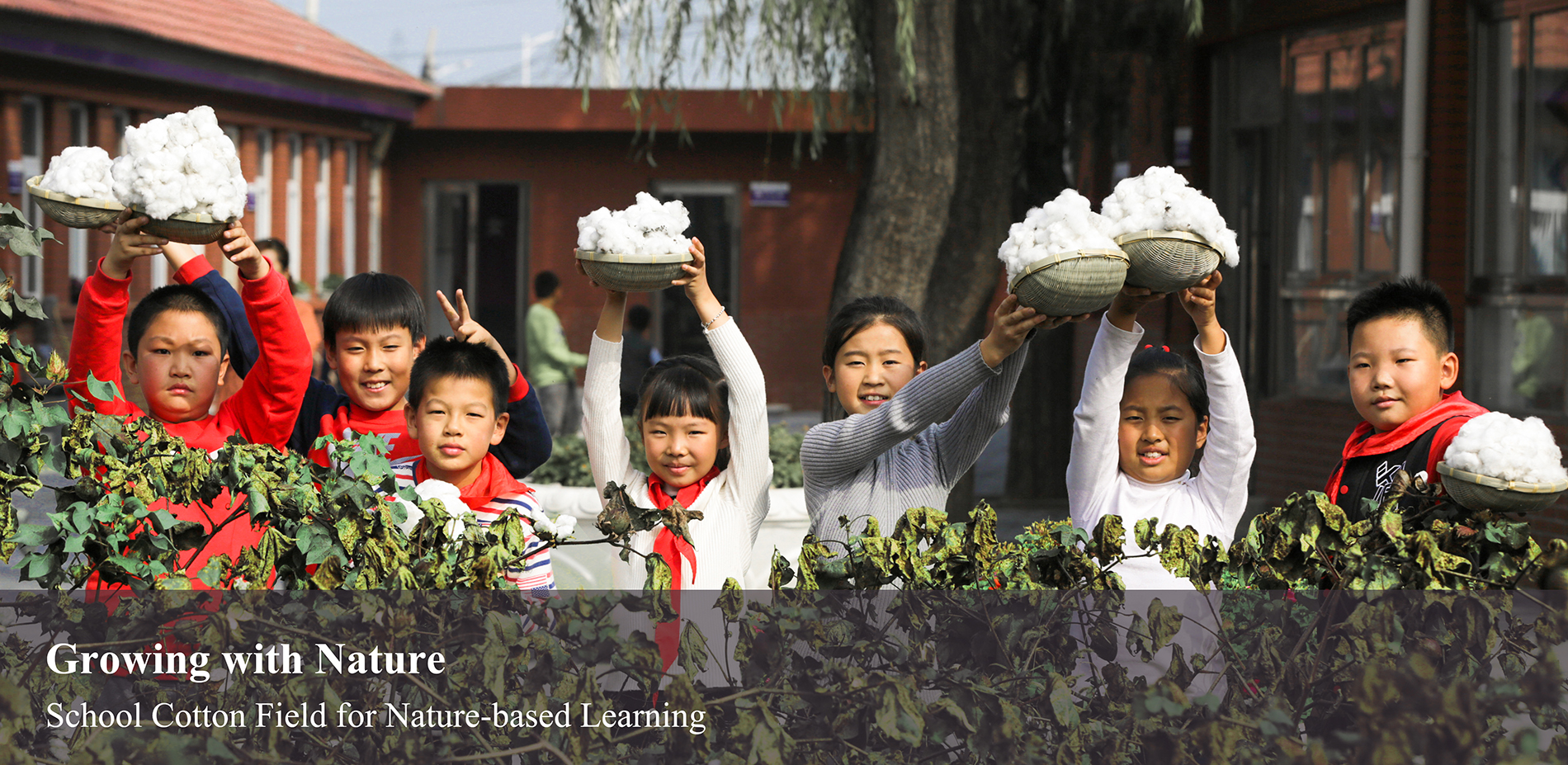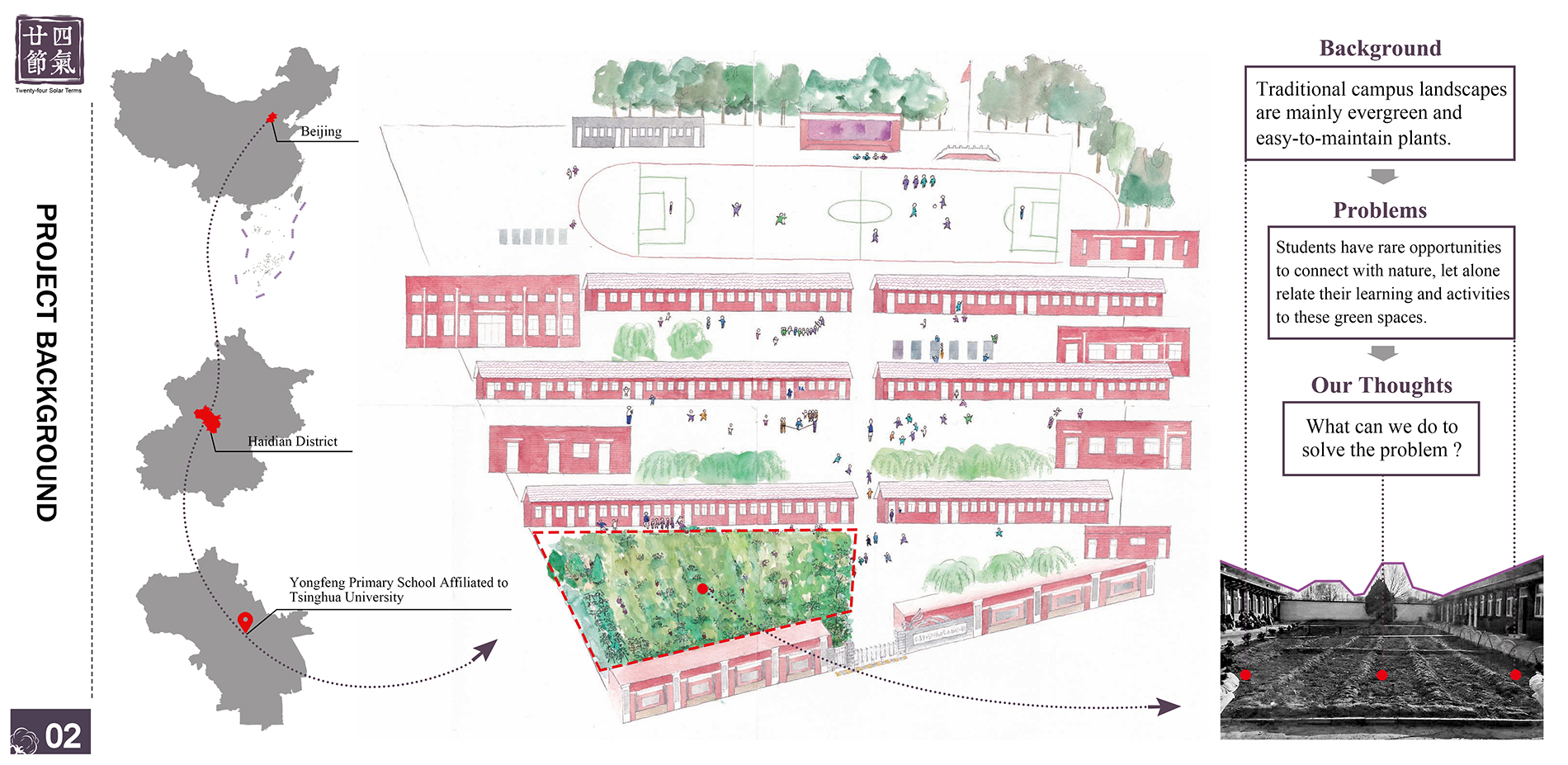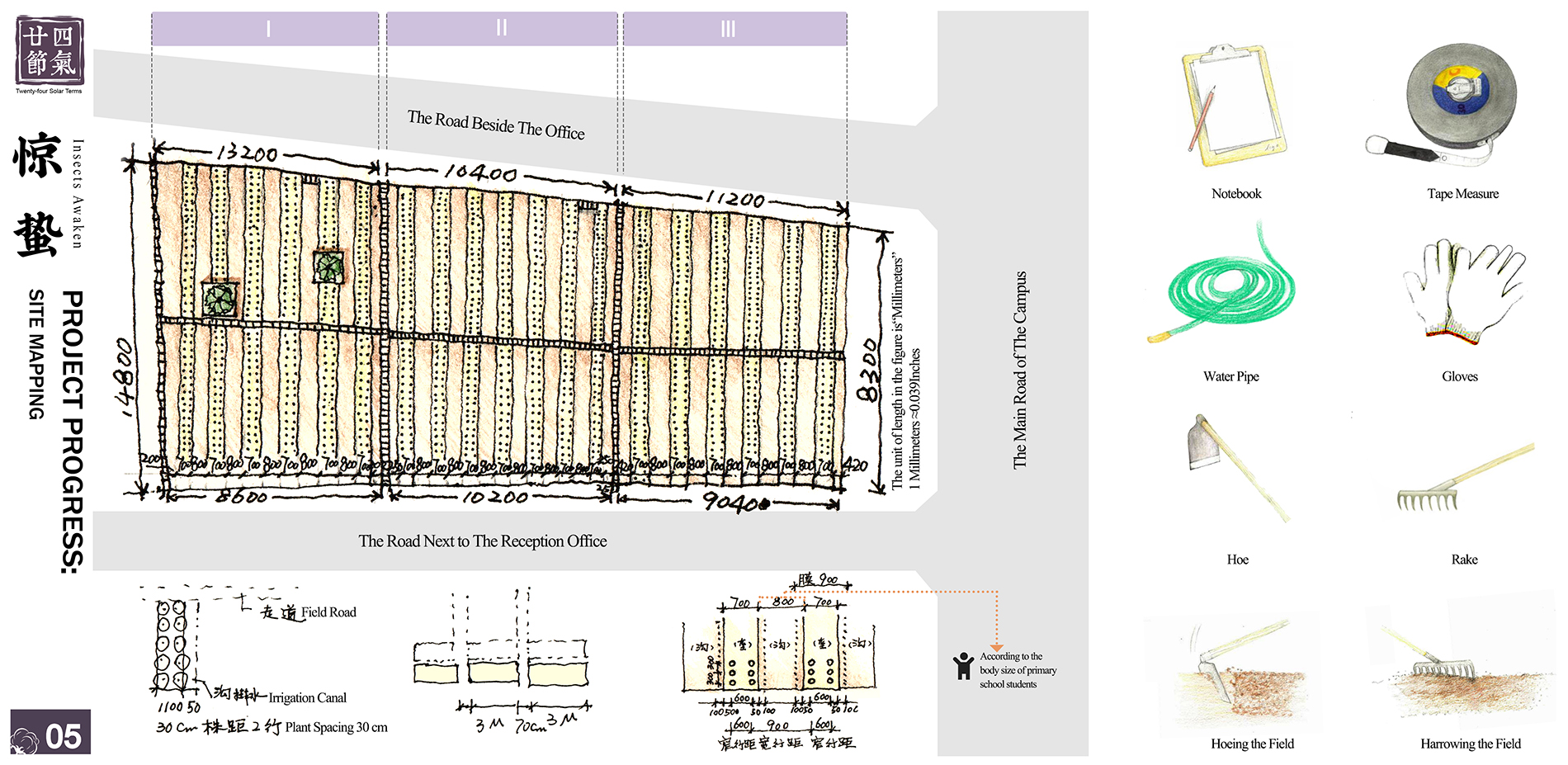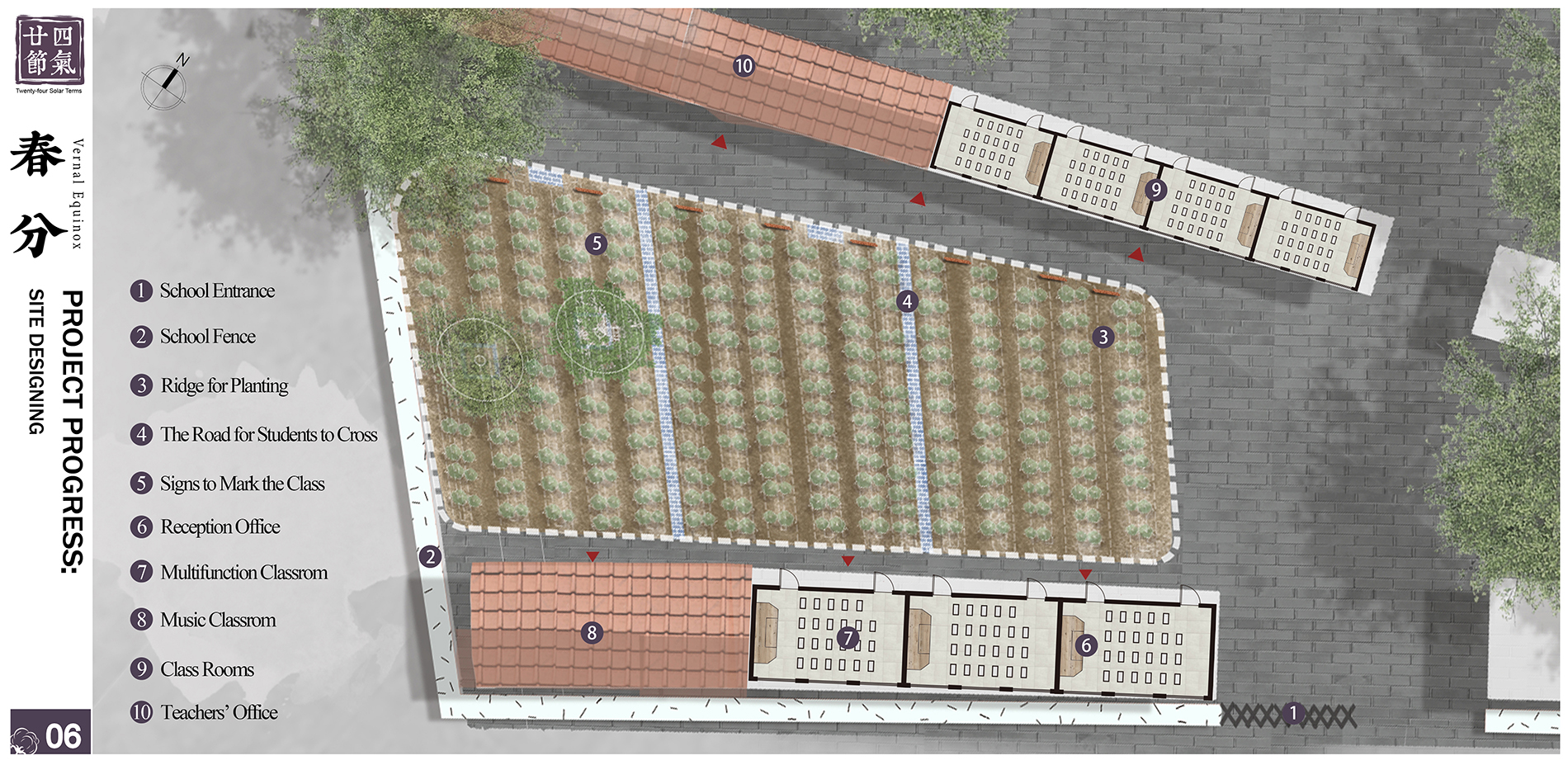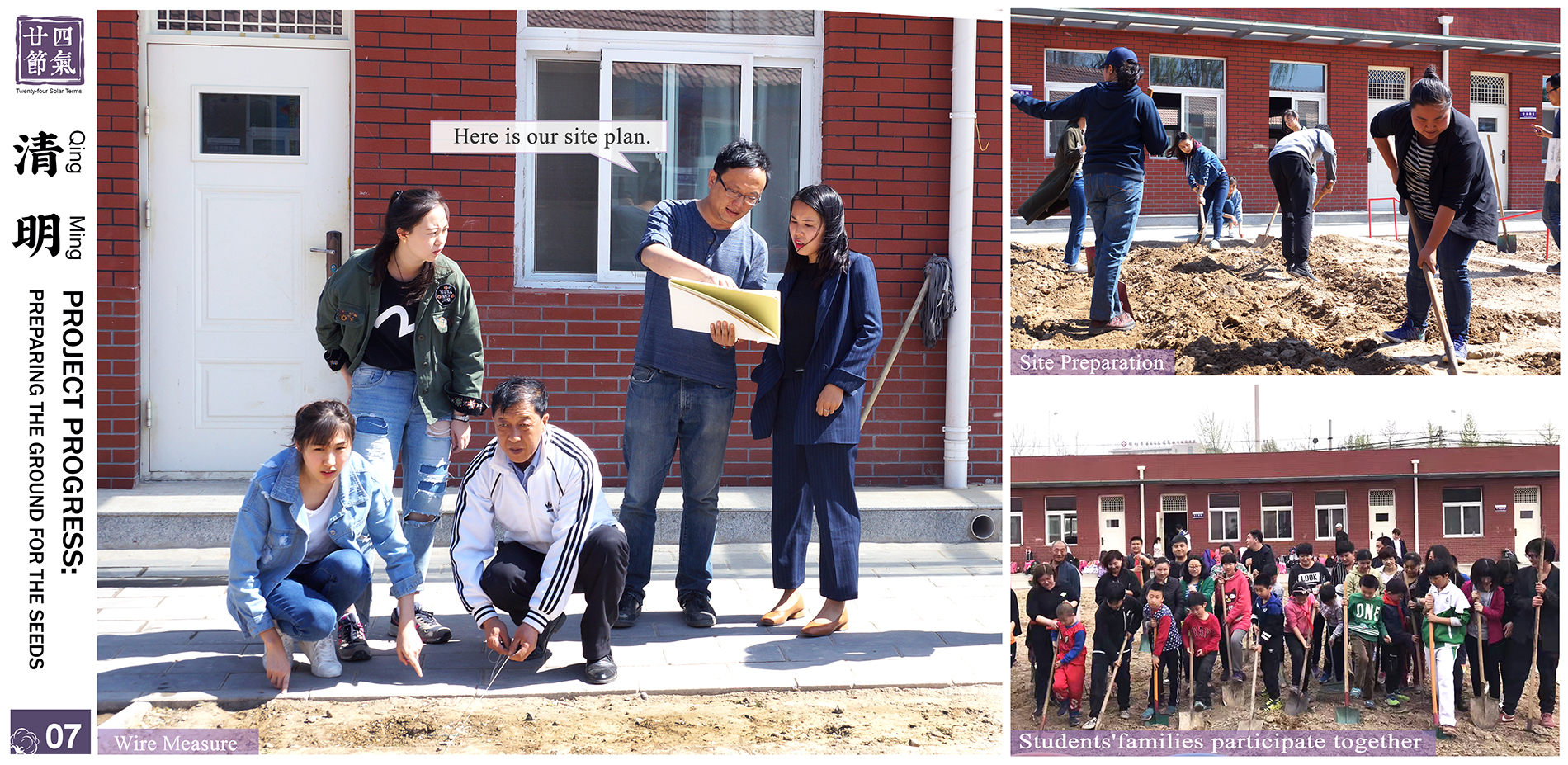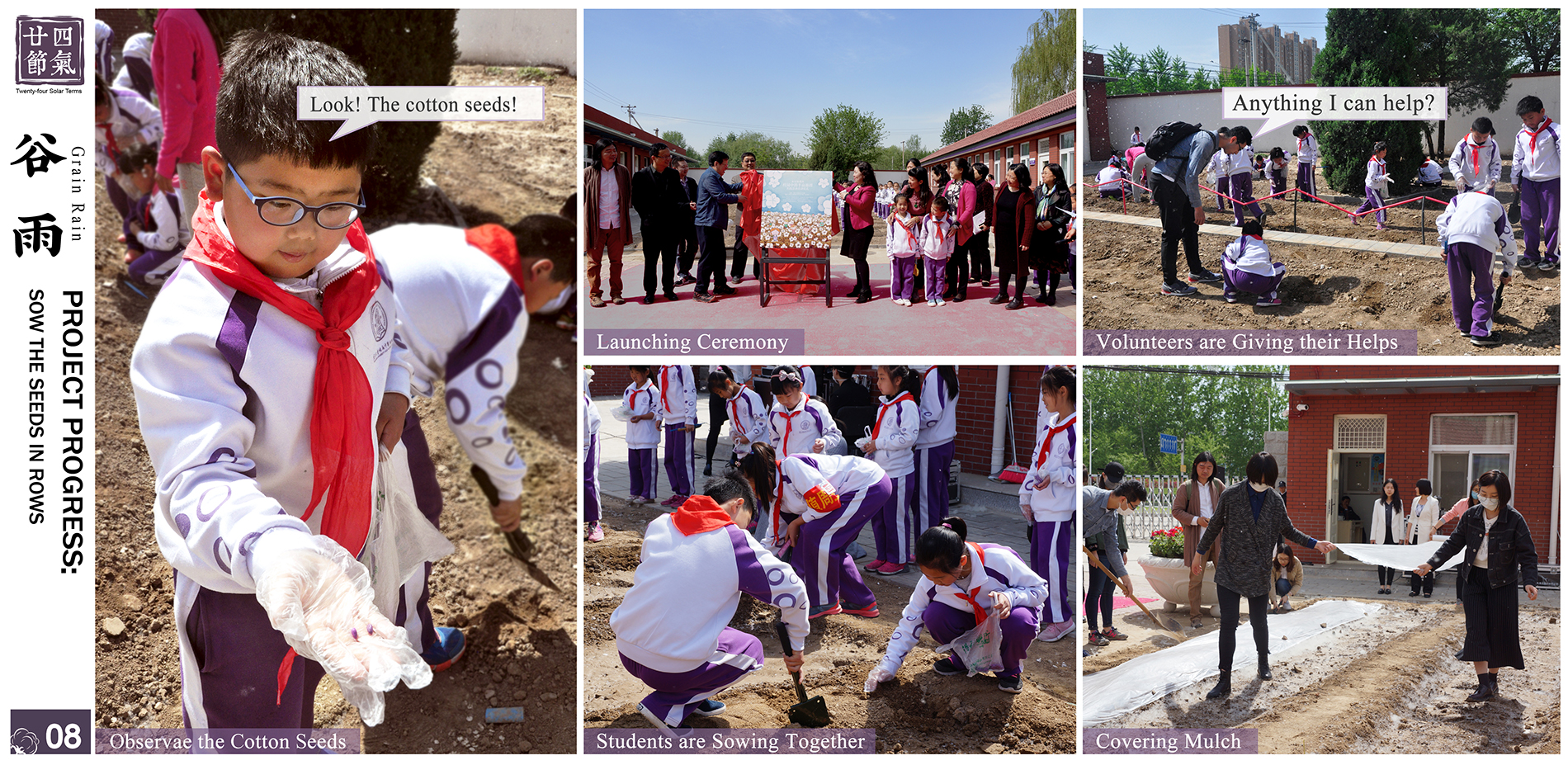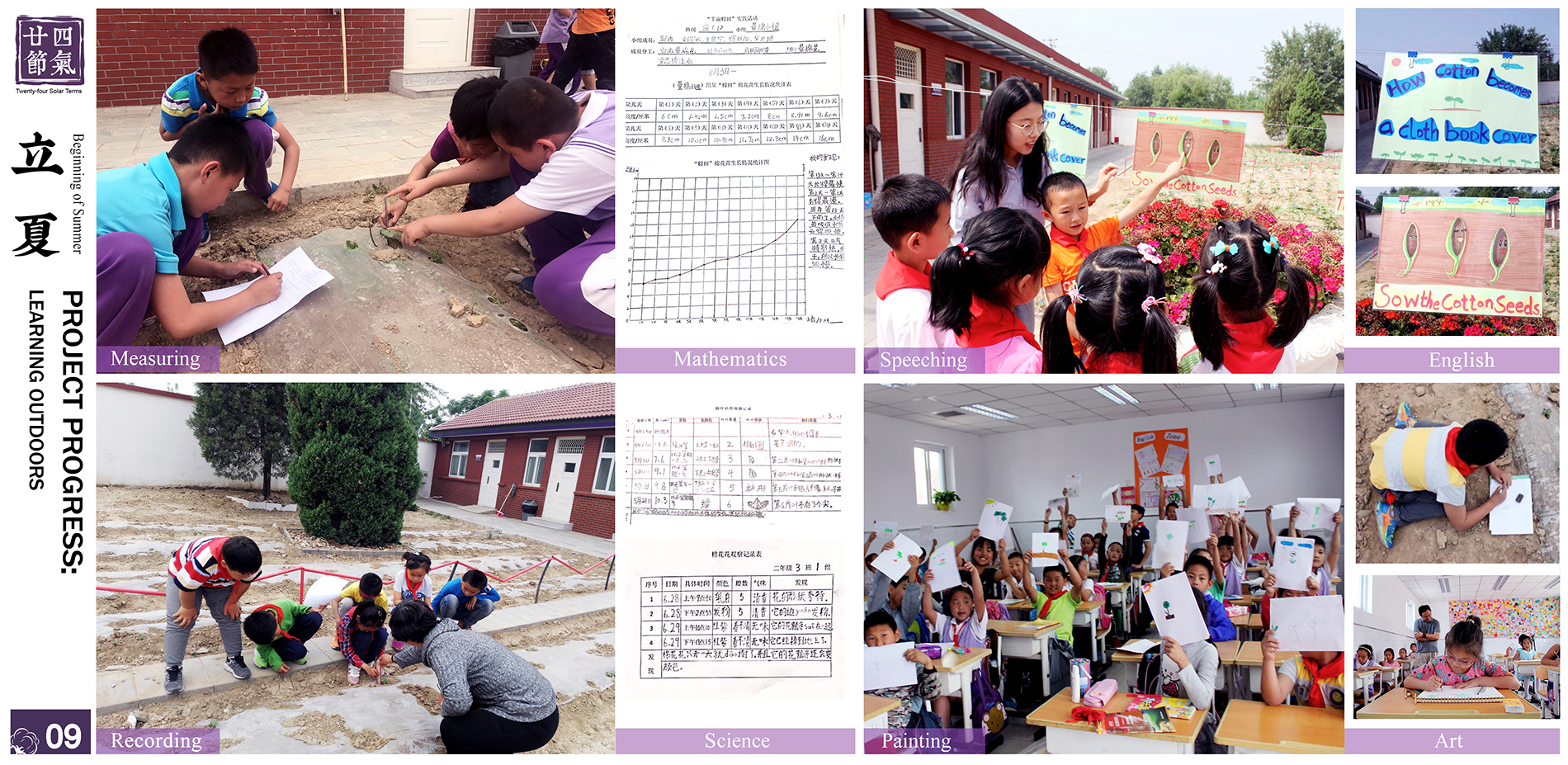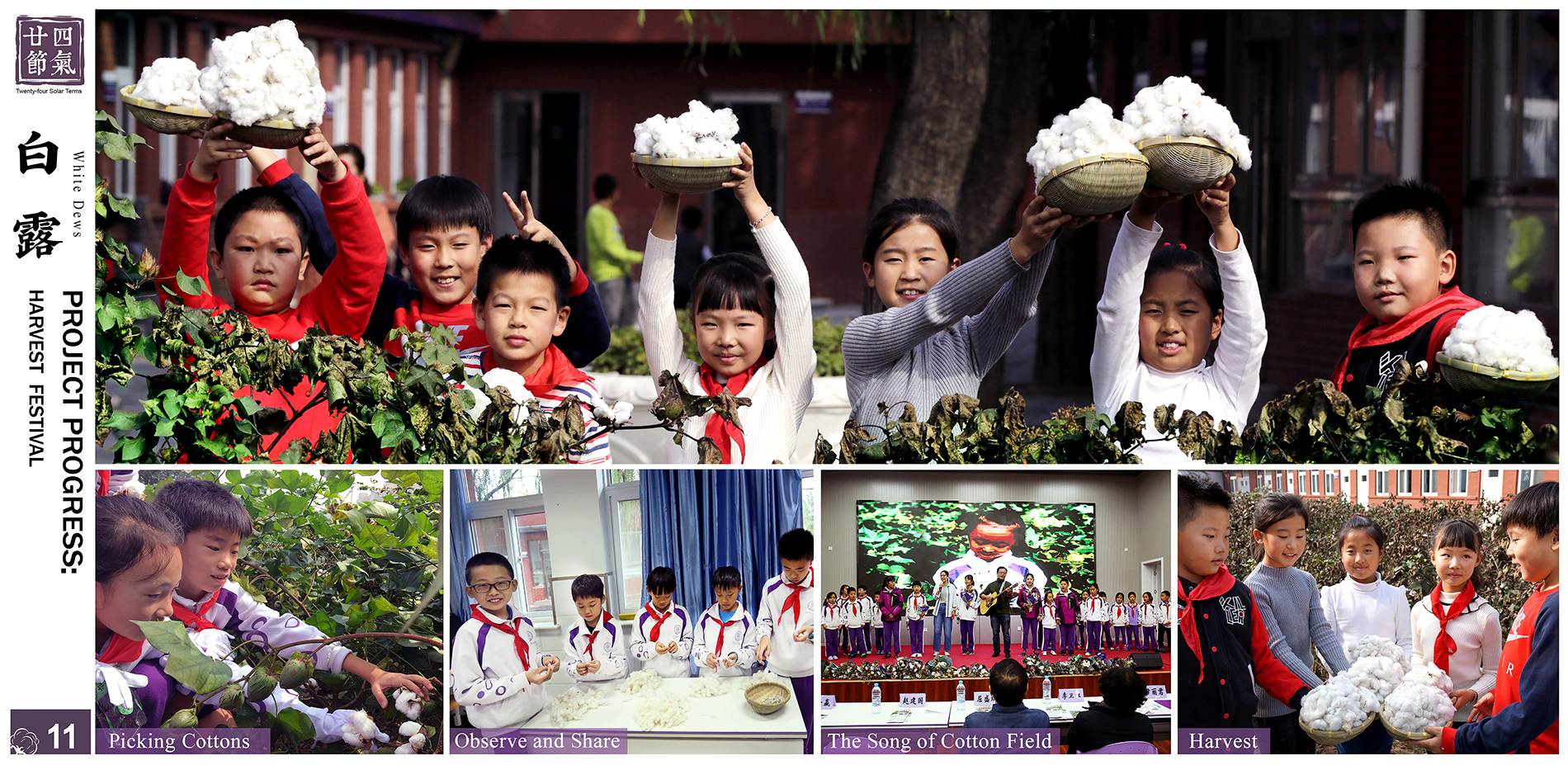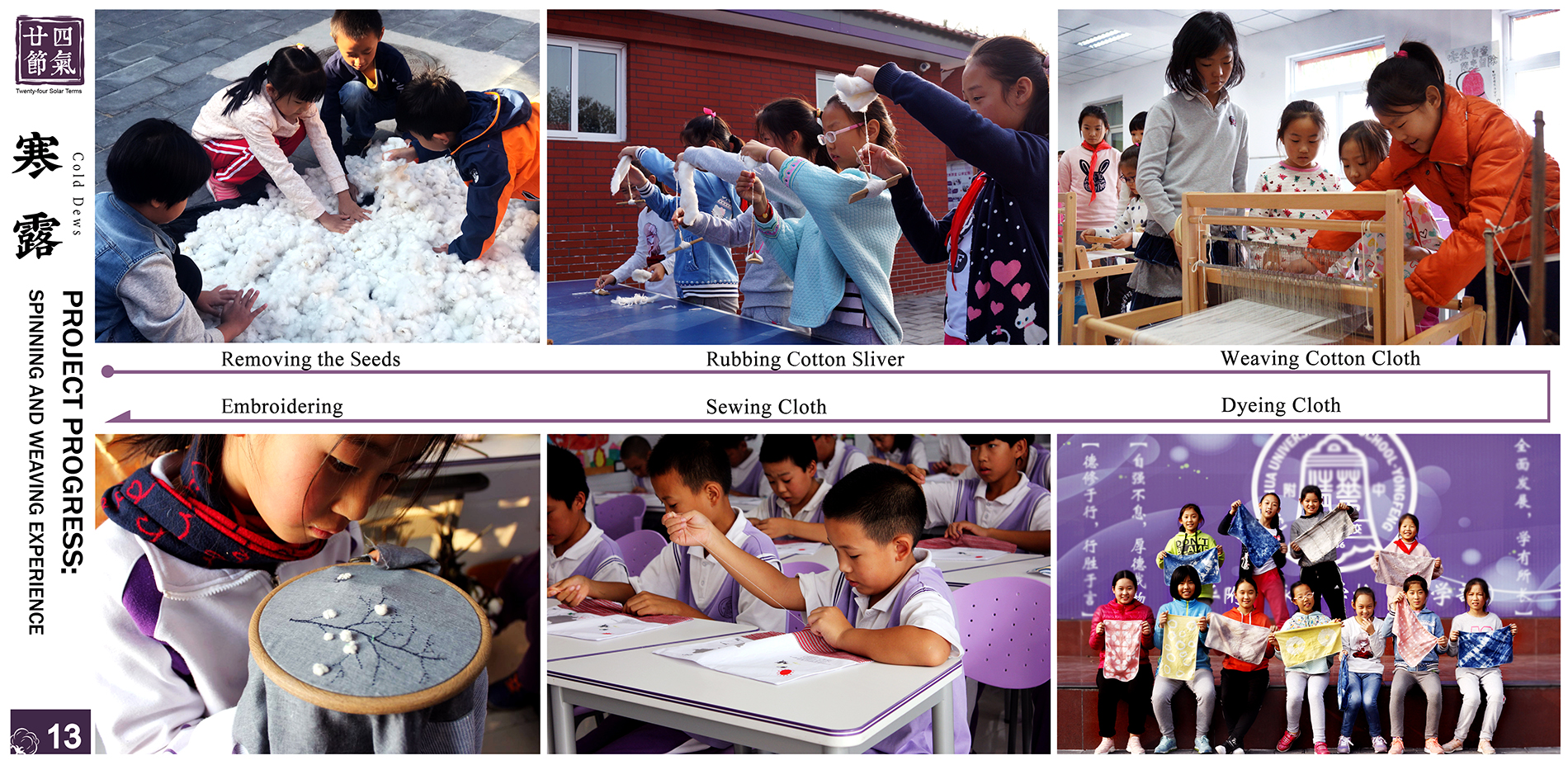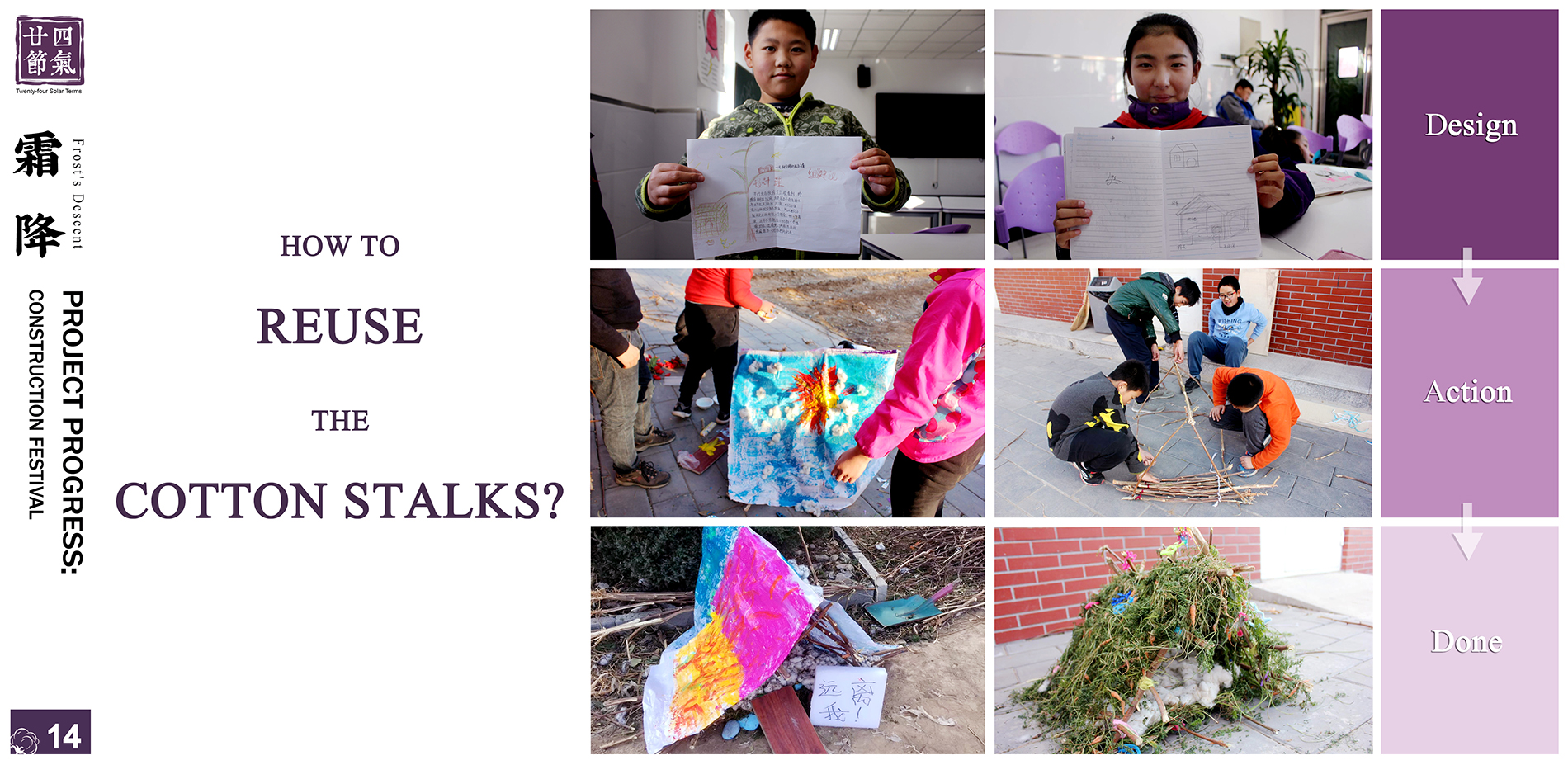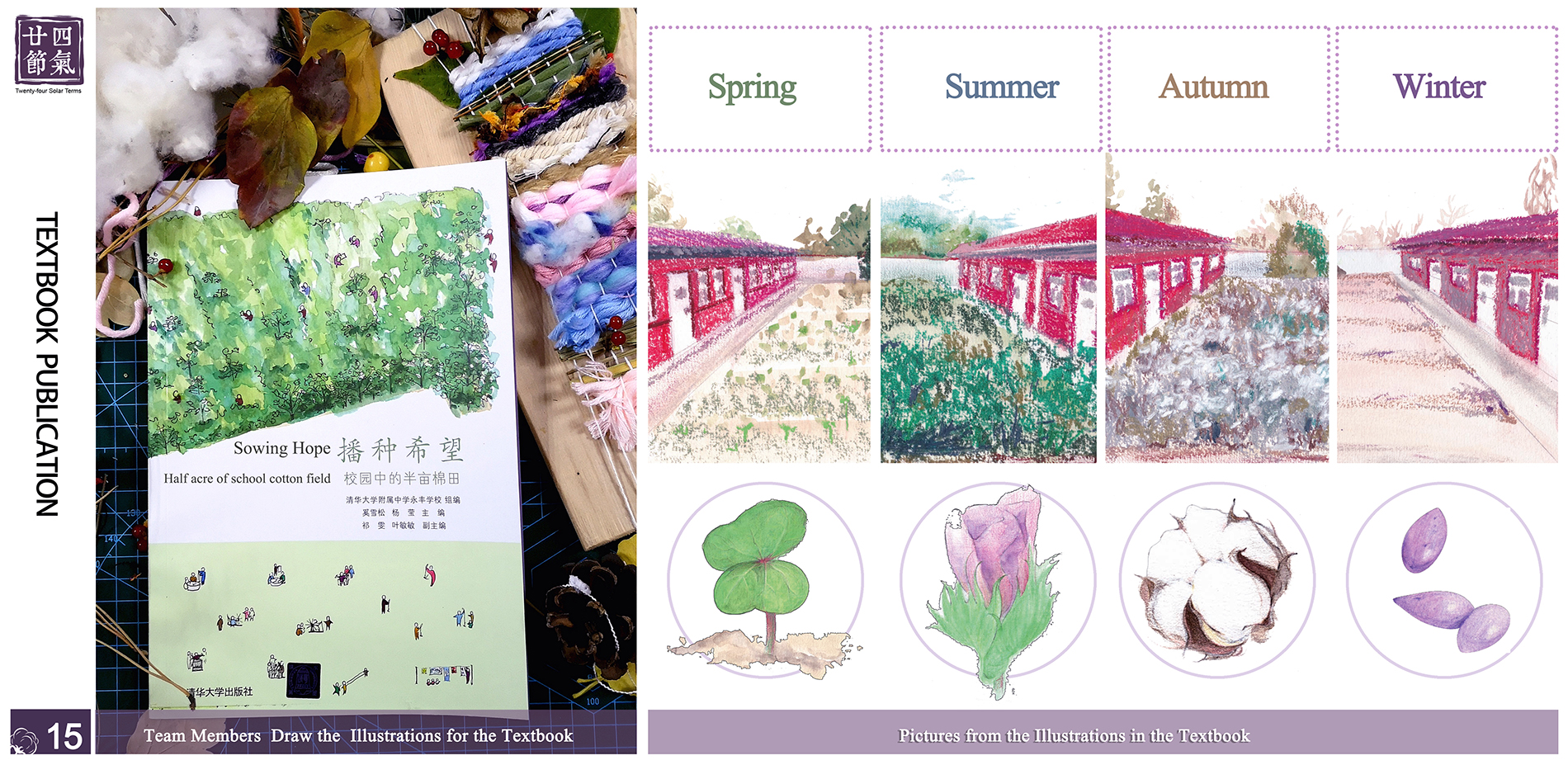Growing With Nature: School Cotton Field for Nature-based Learning
Honor Award
Student Community Service Award
Haidian District, Beijing, China
Xinyue Gong; Xingrun An; Xinxin Chen; Chang Lu; Shifan Liang; Antan Li; Lin Wang; Zekuan Deng; Jiaoyi Xu; Tianyun Lu
Faculty Advisors: Xuesong Xi
China Agricultural University
This project represents a wholly new take on the school and lays out the circular ecology of cotton, going as far as relating it to cultural festivals and mapping out its seasonality in programming. The imagery beautifully illustrates all the ways cotton is used and how it is harvested. Children engaging in tactile acts of harvesting and creating with the cotton is compelling, and we loved how it has impacted so many children, families, and volunteers within these communities.
- 2021 Awards Jury
Project Credits
Dianjun Wang, Weidong Meng, Ying Yang, Wen Qi, Xuesong Yang, Jinhua Qi, Donghui Qiao, Qi Yan
Tsinghua University High School Yong Feng
Tao Wang, Yongsheng Zhang, Xiao Wei, Yu Zang, Zhaotong Lu, Hui Zhang, Yong You, LiFeng Shen, Bo Hua, Shengnan Wang, Shumei Zhao, Weichao Zheng, Qin Tong, Na Duan, Shiwei Huang, Yuhua Wang
China Agricultural University
Jun Wang , Dongyun Wang
High School Afflicted to China Agricultural University
Weiru Jiao, Jin Wang
Primary School of China Agricultural University
JInping Hua, Lingling Ma, Fenlan Zheng, Minmin Ye, Ga Li, Hongmei Li, Yueping Wang, JInling Xue, Miao Zhang, Le Qi
Professional Advisors
Yanli Tao, Miao Sun, Fangxin Liu, LIbo Yue, Kangjing Wen, Qiang Zhao, Shuai Zhang, Rui Gao, Sijie Huang, Yunong Li, Muxue Zhangyi, Shilan Wang, Yuxuan Zhang, Zhengyang Wen, Kaiyan Zhang, Qiyin Zhang, Shaojuan Ge, Xingyu Fang, Xin Chen, Jian Gao, Wanhong Niu, Hexing Chang, Fu Li
Additional Members
Logistics Support Office, CAU
School Administration
Project Statement
Students in cities rarely have the opportunity to be exposed to nature, school green spaces are the best place for them to contact with nature in daily lives. However, it seems that evergreen and easy-to-maintain plants are not attractive enough to catch students attentions. The LA Students in agricultural college comes an idea to replace normal green space into a cotton field. Through a variety of festivals, activities and outdoor lessons, students can enjoy the happiness of growing with nature in the limited school green space, this change also brings better communication opportunities for the school’s faculty and staff, students’ families and other community members.
Project Narrative
In urban primary and secondary schools, there are very limited areas for students to explore outdoor activities besides traditional playground. Campus green space might be the best place for students to connect with nature. However, traditional campus landscapes are mainly evergreen and easy-to-maintain plants. Students have rare opportunities to know about and connect with nature, let alone relate their learning and activities to these green spaces. As landscape major students in agricultural college, we thought of a campus green space transformation plan: replacing green space with farmland and replacing common landscape plants with cotton. All students in school are able to participate from land design to farming activities with volunteer LA students monitoring the whole process. With that students can have an interactive natural area where they grow with cotton together and sense the power of nature and life. At the same time, cotton fields also create an excellent outdoor learning area for Chinese, Mathematics, English and other subjects.
This yearly project is based on lunar calendar and guided by 24 solar terms, allowing students to fully experience all different production stages of cotton planting from Vernal Equinox (March) to White Dews (September). Through different activities from Autumnal Equinox (September) to Frost's Descent (November), students are able to experience the cultural and artistic value of cotton as a material. The farming activities were assigned to 6 different grades according to the difficulty levels but sowing and harvesting were completed by all teachers and students. LA students provided professional guidance to primary students on land design, plant cognition, cotton art creation and construction practice. This project also provided opportunities for community bounding. University faculty and staff contributed by offering professional field management advice. Parents carried out family planting activities and interacted in school community through internet. Some school staff who had farming experience took their advantage into daily field work. Some artists and craftsmen were also invited to hold cotton spinning and weaving activities after the harvest season. The children were encouraged to use cotton for various creations.
When we first proposed this innovative education model in 2017, considering suitable cotton planting conditions, we had an agreement with Yongfeng Primary School Affiliated to Tsinghua University in Haidian District, Beijing. We transformed the green space between classrooms into cotton field as our first tryout. The overall project developments of first year are as follow.
Vernal Equinox (March) -- Mapping and land design
The graduate students visited school site for the first time and measured the basic data of the land with primary students. They also worked out the ridge width, spacing and the number of ridges. They were able to draw a graphic design plan, determine the planting area and the amount of seeds to purchase.
Qing Ming (April) Land preparation
The students were divided into several groups to carry out the basic work of turning soil, laying lines and ridging according to the plan. In this process, students and parents were able to learn how to use farming tools, understand the basic methods of evaluating soil quality and water the land fully to prepare for the next planting activities.
Grain Rain (April) Sowing Festival
In this term, the cold waves are almost passed with the temperature rising faster. This is the best time for cotton sowing. School launched a Sowing Festival on that day. Graduate students assigned responsibility fields and gave out seeds to classrooms. Primary students worked together on sowing tasks. During this process, graduate students led the pupils to observe the appearance of the seeds, learn the facts about the seeds. The primary students also brought some seeds home and invited their parents to participate in this planting activity.
Beginning of Summer to summer solstice (May-June) Outdoor class in the Cotton Field
Beginning of Summer is the first solar term in May with longer day time and hot weather. Plants entered their heyday, providing natural teaching materials for school course. Teachers moved their classroom to the cotton field. Students learned measurement by measuring the height of seedlings in the Math class; wrote cotton poems in Chinese; made cotton related poster in English and gave speeches; observed cotton and insect pests in science class; drew cotton in Art class and wrote songs in Music class. All the students and teachers have gradually built a deep connection with this cotton field. LA students also teach the Plant Cognition course in cotton field.
From Slight Heat to the Limit of Heat (July-August) field management
With the growth of cotton, some pests have come to the door. Except for watering and weeding once a week, students also learned how to recognize pests and deal with pest problems with the help of graduate students and agronomists. During summer break, enthusiastic school staff even took over the field management responsibility, helping the students with the nursing work.
White Dew and Autumn Equinox (September) Harvesting and Art Festival
Months of hard work has resulted in a fruitful harvest. The students traveled through the fields with excitement, picking up cotton. This was the first time for most of them to see the cotton field and grow cotton by themselves. What can we do with these cottons? The students started to think and use cotton as the main material for artworks to express their feelings and thoughts. In addition, the graduate students also invited intangible cultural heritage inheritors who are skillful at cotton spinning and weaving to present the process of using cotton to make a thread and a cloth. Students were also able to experience this traditional handcrafting with the guidance of inheritors.
Frost’s Descent (October) Construction Festival
After the harvest festival, the weather turned cooler and the plants fallen. The cotton stalks became natural waste left in the fields. But the graduate students turned them perfectly into PBL teaching tools for primary graduate project. The theme of the project was “The Reuse of Waste Cotton Stalks”. The waste cotton stalks were the main material. They finally presented 5 construction works after group discussion and planning.
In the process of this one-year project, the campus farmland gave full play to the value of its landscape place, deeply connected the curriculum with practice. This project also helped increase students’ outdoor activity time and build closer relationship with nature. Students understood more about respecting life and cherishing the hard work.
The "School Cotton Field " project has been carried out for 4 years and expanded to 7 primary and secondary schools in 4 cities, influencing more than 6000 people. Crop varieties have also expanded from cotton to corn and more than 10 other varieties according to the different climatic conditions of the schools. In the university, the LA students also set up an association to recruit more volunteers of other majors to participate in the project. Handcrafting activities have been held in Campus for teachers,students and community members. A series of cotton artworks created by primary and secondary school students were also collected and exhibited at the university. The results of the project have been regarded and reported by more than 20 mediums. And the LA students have won awards in multiple competitions for this innovative action. The project was finally compiled into a textbook so that this model could be spread more widely.
Plant List:
- cotton
